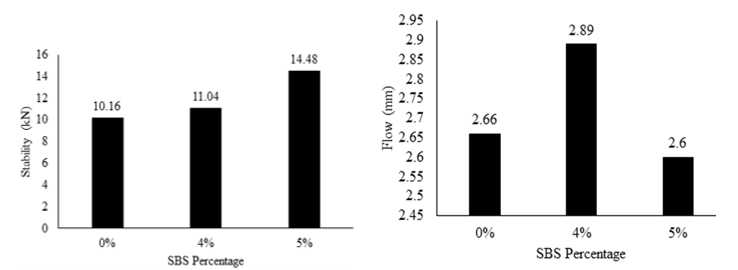Optimizing the Combination of Nitrile-Butadiene Rubber and Styrene-Butadiene-Styrene for Modification of Asphaltic Pavement
DOI:
https://doi.org/10.37934/progee.28.1.2327Keywords:
Bituminous concrete, Flexible pavement, Polymer-modified asphaltAbstract
Modification of asphaltic pavements using nitrile-butadiene rubber (NBR) and styrene-butadiene-styrene (SBS) has been studied in recent years to improve pavement performance and durability while reducing waste from disposal of nitrile gloves. However, in previous studies, the uses of NBR and SBS were evaluated in isolation hence, their use in combination has not been considered. Therefore, in an attempt to use NBR and SBS in combination for modification of asphaltic pavements, hot-mix asphalt (HMA) samples containing varying dosages of NBR and SBS were prepared. Volumetric measurements and Marshall tests were conducted on the samples. Results suggest the incorporation of NBR and SBS at 6 and 5% dosages, respectively, by weight of the bitumen in the HMA, as the optimal combination. The combination led to the highest stability and lowest flow of the HMA, which contribute to the highest increase in stiffness hence highest improvement in strength.
References
P. Deepa, M. Laad, Sangita, Investigation on bitumen modification using nitrile butadiene rubber and low-density polyethylene. Romanian Journal of Transport Infrastructure 9 (2020) 38–51. https://doi.org/10.2478/rjti-2020-0003
L. Brasileiro, F. Moreno-Navarro, R. Tauste-Martínez, J. Matos, M. del Carmen Rubio-Gámez, Reclaimed polymers as asphalt binder modifiers for more sustainable roads: A review. Sustainability 11 (2019) 646. https://doi.org/10.3390/su11030646.
P. J. G. Varghese, D. A. David, A. Karuth, J. F. M. Jafferali, P. M. S. Begum, J. J. George, B. Rasulev, P. Raghavan, Experimental and simulation studies on nonwoven polypropylene–nitrile rubber blend: recycling of medical face masks to an engineering product, ACS Omega 7 (2022) 4791–4803. https://doi.org/10.1021/acsomega.1c04913
A. Chopra, S. Singh, Experimental investigation of modified bituminous concrete mix using nitrile butadiene rubber (NBR), Materials Today: Proceedings 33 (2020) 1660–1665. https://doi.org/10.1016/j.matpr.2020.06.443
P. Cong, X. Guo, L. Mei, Investigation on rejuvenation methods of aged SBS modified asphalt binder, Fuel 279 (2020) 118556. https://doi.org/10.1016/j.fuel.2020.118556
H. Li, C. Cui, A. A. Temitope, Z. Feng, G. Zhao, P. Guo, Effect of SBS and crumb rubber on asphalt modification: a review of the properties and practical application, Journal of Traffic and Transportation Engineering 9 (2022) 836–863. https://doi.org/10.1016/j.jtte.2022.03.002
C. Yan, W. Huang, P. Lin, Y. Zhang, Q. Lv, Chemical and rheological evaluation of aging properties of high content SBS polymer modified asphalt, Fuel 252 (2019) 417–426. https://doi.org/10.1016/j.fuel.2019.04.022
Public Works Department Malaysia, Standard Specification for Road Works: Section 4: Flexible Pavement (JKR/SPJ/2008-S4), Public Works Department Malaysia, 2007.

Downloads
Published
How to Cite
Issue
Section
License
Copyright (c) 2024 Progress in Energy and Environment

This work is licensed under a Creative Commons Attribution-NonCommercial 4.0 International License.











